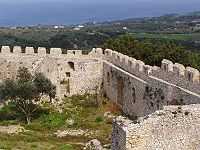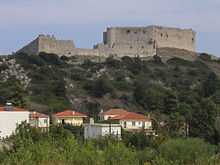Chlemoutsi
Coordinates: 37°53′25″N 21°08′31″E / 37.89028°N 21.14194°E


Chlemoutsi (Greek: Χλεμούτσι or Χλουμούτσι) is a medieval castle in the northwest of the Elis regional unit, Greece, 12 km west of Andravida, 13 km southwest of Lechaina and 6 km south of Kyllini. It was built by the Crusader rulers of the Principality of Achaea as their main stronghold, and is perhaps the finest fortification of the early Frangokratia period preserved in Greece.[1] Its Greek name comes from the medieval Chronicle of Morea and is a corruption of its original French name, Clairmont. During the Venetian period, it was known as Castel Tornese, since the Venetians erroneously believed that it was the seat of the Principality's mint (it was located in nearby Glarentza), which minted the silver gros tournois coins.[2][3]
History

The castle was built between 1220 and 1223 during the rule of Geoffrey I of Villehardouin, with the use of confiscated Church property.[1][4][5] The castle overlooked and defended the port town of Glarentza.[6]
After the death of Geoffrey II Villehardouin, the castle followed the fortunes of the Principality. The Catalans under Ferdinand of Majorca took it in 1315, but he was defeated and killed a year later by Louis of Burgundy. In the beginning of the 15th century, the castle passed into the hands of Carlo I Tocco. After the 1427 Battle of the Echinades, through his marriage with Maddalena Tocco, the Despot of the Morea, Constantine Palaiologos (the future last Byzantine emperor) gained possession of Elis, including the castle. Constantine established his court there, and it remained one of the seats of the Despotate until its capture by the Ottomans in 1460.
The area remained under Ottoman control until the Republic of Venice conquered the Peloponnese in the Morean War, with Chlemoutsi falling to Venetian hands in 1687. Venetian rule was brief, as the Ottomans recaptured the area in 1715, and held on to it until the Greek War of Independence in 1821. On 10 November 1825, the forces of Ibrahim Pasha of Egypt took the castle, where numerous locals had fled, after a brief siege and bombardment, which caused great damage to its southern walls. Following the Egyptian withdrawal in 1828, the castle, partly razed by the Egyptians, became part of the modern Greek state.
Chlemoutsi was the most important castle built by the Franks in the Principality of Achaea and it remained important after the end of the Frankish occupation, retaining close connections with the West (especially Italy) throughout the period between the 13th and the early 19th century. [7]
The castle today
Today the castle is a preserved landmark. Lights added to the castle in the mid- to late 20th century and can be seen as far as 80 km by night. The castle hosts musical and other events every summer.
Location


Chlemoutsi is located on a 220 m high hilltop at a small distance from the sea (around 2 to 2.5 km) in the westernmost point in the Peloponnese with a view of the Ionian Sea as well as Zakynthos and Kefalonia, also the small islets. Its strategic position offers views of large parts of Elis and Achaea. It was located close to the Glarentza Castle (around 5 to 6 km) and Andravida (around 12 to 13 km), the capital of the Principality of Achaea.
Architecture

The history of the castle's construction survives in the Chronicle of Morea.[8] The castle consists of a large hexagonal keep at the top of the hill, while the more vulnerable sides are further enclosed by an outer wall. The castle was well suited for a princely residence: its halls, arranged around the inner courtyard, were spacious, comfortable, and well-lit, cool in the summer and provided with several fireplaces for the winter months.[1] However, the architectural characteristics of the main keep are out of the ordinary for its supposed period of construction, and more in line with 15th-century structures, which has led to uncertainty over its exact dating.[9]
References
- ↑ 1.0 1.1 1.2 Nicolle (2007), p. 25
- ↑ Chlemoutsi Castle
- ↑ Sotiriou G.: Le Château-fort de Chlemoutsi et son Atelier Monetaire de Tournois de Clarentia, Journal International d’ Archeologie Numismatique, XIX, 1916-1917, 273-279.
- ↑ Traquair R.: Laconia; I. Medieval Fortress, Annual of the British School at Athens XII (1906), 272-276.
- ↑ Wallace D., Boase T. S. R.: The Arts in Frankish Greece and Rhodes, A History of the Crusades. (Hrsg.) Setton K. M., Band IV, The Art and Architecture of the Crusader States, (Hrsg.) Hazard, H. W. Madison 1977, 218.
- ↑ Bon A.: La Morée franque., Paris 1969 in P. Hetherington: Byzantine and Medieval Greece. Churches, castles and art of the mainland and Peloponnese. London 1991. A
- ↑ Skartsis, Stefania S. (2012): Chlemoutsi Castle (Clermont, Castel Tornese), NW Peloponnese. Its Pottery and its Relations with the West (13th - Early 19th Centuries). Bar International Series 2391. ISBN 9781407309835.
- ↑ History of the building of the Chlemoutsi Castle in the Morean Chronicle (at the Greek Wikisource)
- ↑ Nicolle (2007), p. 27
Sources
- Andrews, Kevin A.; Bugh, Glenn R. (2006). Castles of the Morea. American School of Classical Studies at Athens. ISBN 978-0-87661-406-8.
- Nicolle, David (2007). Crusader Castles in Cyprus, Greece and the Aegean, 1191–1571 (Fortress Series #59). Osprey Publications. ISBN 978-1-84176-976-9.
- Ottersbach, Christian. "Chlemoutsi - ein Höhepunkt hochmittelalterlichen Burgenbaus in Griechenland". Marburger Correspondenzblatt zur Burgenforschung (in German) (Heft 2, 1999/2000).
- Ralli, A. (2007). "Κάστρο Χλεμούτσι ("Chlemoutsi Castle")" (in Greek). Hellenic Ministry of Culture. Retrieved 9 December 2008.
External links
- Chlemoutsi – Glarentza, GothicMed
- Chlemoutsi
- History of the Castle at the Kastro-Kyllinis Homepage (Greek)
- The Castle of Chlemoutsi
Gallery
-

Chlemoutsi from the sea, the Ionian
-

Chlemoutsi from the side of the sea
-
Chlemoutsi from the village of Kastro
-
The inner part of the castle
-

In the castle
-

A gangway in the castle


